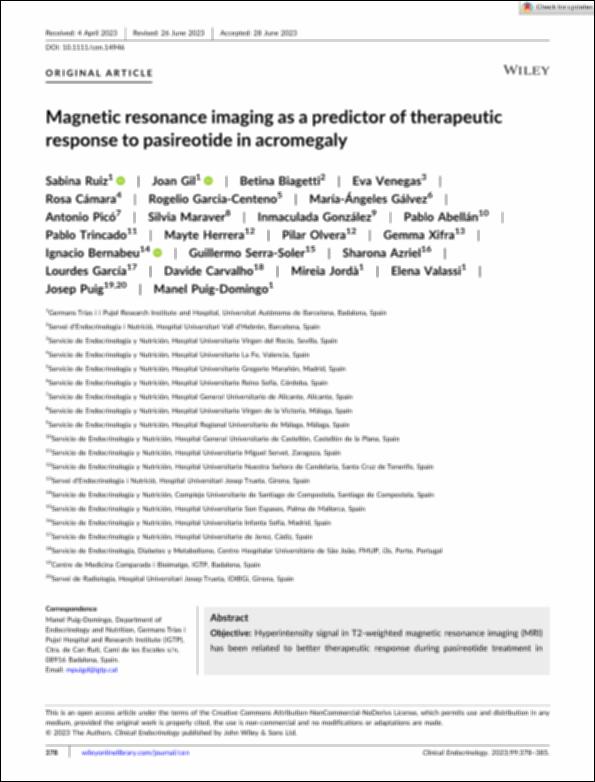Please use this identifier to cite or link to this item:
http://hdl.handle.net/10637/16438Magnetic resonance imaging as a predictor of therapeutic response to pasireotide in acromegaly
| Title: | Magnetic resonance imaging as a predictor of therapeutic response to pasireotide in acromegaly |
| Authors : | Ruiz, Sabina Gil, Joan Biagetti, Betina Venegas, Eva Cámara, Rosa García Centeno, Rogelio Abellán Galiana, Pablo |
| Keywords: | Diagnóstico médico; Medical diagnosis; Enfermedad rara; Orphan disease; Tratamiento médico; Medical treatment; Hormona; Hormones; Enfermedad endocrina; Endocrine disease |
| Publisher: | John Wiley & Sons |
| Citation: | Ruiz, S., Gil, J., Biagetti, B., Venegas, E., Cámara, R., Garcia-Centeno, R., Gálvez, M.Á., Picó, A., Maraver, S., González, I., Abellán, P., Trincado, P., Herrera, M., Olvera, P., Xifra, G., Bernabeu, I., Serra-Soler, G., Azriel, S., García, L., Carvalho, D., … Puig-Domingo, M. (2023). Magnetic resonance imaging as a predictor of therapeutic response to pasireotide in acromegaly. Clinical Endocrinology, 99(4), 378–385. https://doi.org/10.1111/cen.14946 |
| Abstract: | Objective: Hyperintensity signal in T2-weighted magnetic resonance imaging (MRI) has been related to better therapeutic response during pasireotide treatment in acromegaly. The aim of the study was to evaluate T2 MRI signal intensity and its relation with pasireotide therapeutic effectiveness in real-life clinical practice. Design, Patients and Measurements: Retrospective multicentre study including acromegaly patients treated with pasireotide. Adenoma T2-weighted MRI signal at diagnosis was qualitatively classified as iso-hyperintense or hypointense. Insulin-like growth factor (IGF-I), growth hormone (GH) and tumour volume reduction were assessed after 6 and 12 months of treatment and its effectiveness evaluated according to baseline MRI signal. Hormonal response was considered ‘complete’ when normalization of IGF-I levels was achieved. Significant tumour shrinkage was defined as a volume reduction of ≥25% from baseline. Results: Eighty-one patients were included (48% women, 50 ± 1.5 years); 93% had previously received somatostatin receptor ligands (SRLs) treatment. MRI signal was hypointense in 25 (31%) and hyperintense in 56 (69%) cases. At 12 months of follow-up, 42/73 cases (58%) showed normalization of IGF-I and 37% both GH and IGF-I. MRI signal intensity was not associated with hormonal control. 19/51 cases (37%) presented a significant tumour volume shrinkage, 16 (41%) from the hyperintense group and 3 (25%) from the hypointense. Conclusions: T2-signal hyperintensity was more frequently observed in pasireotide treated patients. Almost 60% of SRLs resistant patients showed a complete normalization of IGF-I after 1 year of pasireotide treatment, regardless of the MRI signal. There was also no difference in the percentage tumour shrinkage over basal residual volume between the two groups. |
| URI: | http://hdl.handle.net/10637/16438 |
| Rights : | http://creativecommons.org/licenses/by-nc-nd/4.0/deed.es Open Access |
| ISSN: | 0300-0664 1365-2265 (Electrónico) |
| Issue Date: | Oct-2023 |
| Center : | Universidad Cardenal Herrera-CEU |
| Appears in Collections: | Dpto. Medicina y Cirugía |
Items in DSpace are protected by copyright, with all rights reserved, unless otherwise indicated.


